Introduction
There is always that day when you are called upon to provide a solution to a network problem. The number of problems that can occur in a network are numerous and believe it or not, most of them can be avoided if the initial design and installation of the network are done properly.
This article covers subnetting guidelines. These are used to correctly design and implement networks of any size.
When I say "done properly" I don't just mean connecting the correct wires into the wall sockets ! Looking at it from an Administrator's point of view, I'd say that a "properly done job" is one that has had a lot of thought put into it to avoid silly routing problems and solve today's and any future needs.
This page contains all the information you need to know in order to design a network that won't suffer from any of the above problems. I've seen some network setups which suffered from all the above, and you would be amazed how frequently I see them at large companies.
Guidelines - Plan for Growth
When creating subnets for your network, answer the following questions:
- How many subnets are needed today?Calculate the maximum number of subnets required by rounding up
the maximum number to the nearest power of two.
For example, if an organization needs five subnets, 2 to the power of 2 will not provide enough subnet addressing space, so you must round up to
2 to the power of 3 = 8 subnets. - How many subnets are needed in the future?You must plan for future growth. For example, if 9 subnets are
required today, and you choose to provide for 2 to the power of 4 = 16 subnets, this
might not be enough when the seventeenth subnet needs to be deployed.
In this example, it might be wise to provide for more growth and
select 2 to the power of 5 = 32 as the maximum number of subnets. - What are the maximum number of hosts on a given segment?You must ensure that there are enough bits available to assign host
addresses to the organization’s largest subnet.
If the largest subnet needs to support 40 host addresses today, 2 to the power of 5 =
32 will not provide enough host address space, so you would need
to round up to 2 to the power of 6 = 64. - How many hosts will there be in the future?Besides planning for additional subnets, you must also plan for more
hosts to be added to each subnet in the future.
Make sure the organization’s address allocation provides enough
bits to deploy the required subnet addressing plan.When developing subnets, class C addresses present the greatest
challenge because fewer bits are available to divide between subnet
addresses and host addresses. If you accommodate too many
subnets, there may be no room for additional hosts and growth in
the future.
All the above points will help you succeed in creating a well designed network which will have the ability to cater for any additional future requirements. And if you do happen to have any problems, well, there is always the website's forum where you can post your questions and problems :)
| IP Subnetting - The Basic Concepts |
IntroductionThis page covers basic subnetting. We learn the default subnet masks and the effect they have on any network. What is Subnetting ? When we Subnet a network, we basically split it into smaller networks. For example, when a set of IP Addresses is given to a company, e.g 254 they might want to "break" (the correct term is "partition") that one network into smaller ones, one for each department. This way, their Technical department and Management department can each have a small network of their own. By subnetting the network we can partition it to as many smaller networks as we need and this also helps reduce traffic and hides the complexity of the network. By default, all type of Classes (A, B and C) have a subnet mask, we call it the "Default Subnet mask". You need to have one because: 1) All computers need the subnet mask field filled when configuring IP 2) You need to set some logical boundaries in your network 3) You should at least enter the default subnet mask for the Class you're using In the previous pages I spoke about IP Classes, Network IDs and Host IDs, the fact is that the Subnet mask is what determines the Network ID and Host ID portion of an IP Address. The table below shows clearly the subnetmask that applies for each network Class. 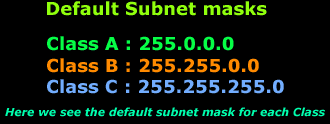 When dealing with subnet masks in the real world, we are free in most cases to use any type of subnet mask in order to meet our needs. If for example we require one network which can contain up to 254 computers, then a Class C network with its default subnet mask will do fine, but if we need more, then we might consider a Class B network with its default subnet mask. Note that the default subnet masks have been set by the IEEE committee, the same guys that set and approve the different standards and protocols. We will have a closer look at this later on and see how we can achieve a Class C network with more than 254 hosts. Understanding the concept Let's stop here for one moment and have a look at what I mean by partitioning one network into smaller ones by using different subnet masks. The picture below shows our example network (192.168.0.0). All computers here have been configured with the default Class C subnet mask (255.255.255.0): 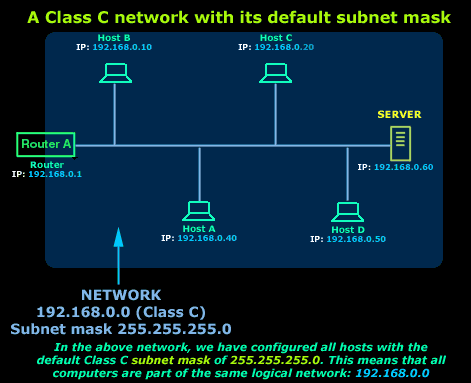 Because of the subnet mask we used, all these computers are part of the one network marked in blue. This also means that any one of these hosts (computers, router and server) can communicate with each other. If we now wanted to partition this network into smaller segments, then we would need to change the subnet mask appropriately so we can get the desired result. Let's say we needed to change the subnet mask from 255.255.255.0 to 255.255.255.224 on each configured host. The picture below shows us how the computers will see the network once the subnet mask has changed: 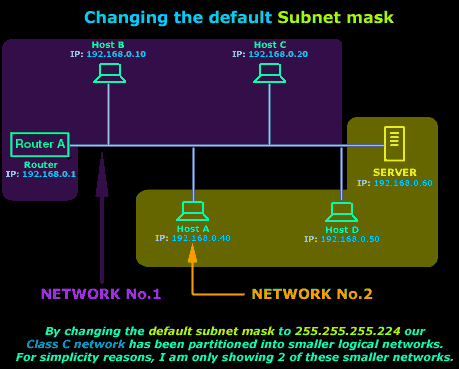 In reality, we have just created 8 networks from the one large (blue) network we had, but I am keeping things simple for now and showing only 2 of these smaller networks because I want you to understand the concept of subnetting and see how important the subnet mask is. In the next pages which are to follow I will analyse in great depth the way subnetting works and how to calculate it. It is very important that you understand the concepts introduced in this section, so make sure you do, before continuing ! |
Introduction
There are a few different ways to approach subnetting and it can get confusing because of the complexity of some subnets and the flexibility they offer. For this reason I created this little paragraph to let you know how we are going to approach and learn subnetting. So.....
We are going to analyse the common subnet masks for each Class, giving detailed examples for most of them and allowing you to "see" how everything is calculated and understand the different effects a subnet mask can have as you change it. Once you have mastered this, you can then go on and create your custom subnet masks using any type of Class.
Default Subnet masks of each Class
By now you should have some idea what the subnet mask does and how it's used to partition a network. What you need to keep in mind is that each Class has its DEFAULT subnet mask, which we can change to suit our needs. I have already mentioned this in the previous page, but we need to look into it in a bit more detail.
The picture below shows our 3 Network Classes with their respective default subnet mask:

The Effect of a Subnet Mask on an IP Address
In the IP Classes page we analysed and showed clearly how an IP Address consists of two parts, 1) The Network ID and 2) The Host ID. This rule applies for all IP Addresses that use the default subnet mask and we call them Classful IP Addresses.
We can see this once again in the picture below, where the IP Address is analysed in Binary, because this is the way you should work when dealing with subnet masks:
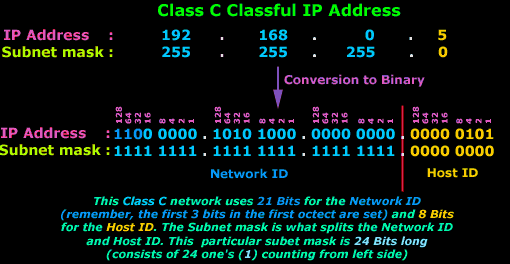
We are looking at an IP Address with its subnet mask for the first time. What we have done is take the decimal subnet mask and converted it to binary, along with the IP Address. It is essential to work in binary because it makes things clearer and we can avoid making silly mistakes. The ones (1) in the subnet mask "lock" or, if you like, define the Network ID portion. If we change any bit within the Network ID of the IP Address, then we immediately move to a different network. So in this example, we have a 24 bit subnet mask.
NOTE:
All Class C Classful IP Addresses have a 24 bit subnet mask (255.255.255.0).
All Class B Classful IP Addresses have a 16 bit subnet mask (255.255.0.0).
All Class A Classful IP Addresses have an 8 bit subnet mask (255.0.0.0).
On the other hand, the use of an IP Address with a subnet mask other than the default results in the standard Host bits (the Bits used to indentify the HOST ID) being divided in to two parts: a Subnet ID and Host ID. These type of IP Addresses are called Classless IP Addresses.
In order to understand what a "Classless IP Address" is without getting confused, we are going to take the same IP Address as above, and make it a Classless IP Address by changing the default subnet mask:
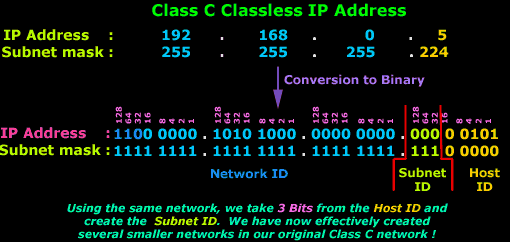
Looking at the picture above you will now notice that we have a Subnet ID, something that didn't exist before. As the picture explains, we have borrowed 3 bits from the Host ID and used them to create a Subnet ID. Effectively we partitioned our Class C network into smaller networks.
If you're wondering how many smaller networks, you'll find the answer on the next page. I prefer that you understanding everything here rather than blasting you with more Subnet ID's, bits and all the rest :)
Summary
In this page we saw the default subnet mask of each Class and also introduced the Classful and Classless IP Addresses, which are a result of using various subnet masks.
When we use IP Addresses with their default subnet masks, e.g 192.168.0.10 is a Class C IP Address so the default subnet mask would be 255.255.255.0, then these are "Classful IP Addresses".
On the other hand, Classless IP Addresses have their subnet mask modified in a way so that there is a "Subnet ID". This Subnet ID is created by borrowing Bits from the Host ID portion.
The picture below shows us both examples:
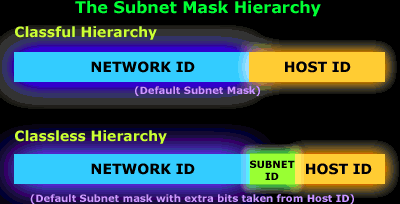
I hope that you have understood the new concepts and material on this page. Next we are going to talk about subnet bits, learn how to calculate how many bits certain subnet masks are and see the different and most used subnet masks available.
If you think you might have not understood a few sections throughout this page, I would suggest you read it once more :)
No comments:
Post a Comment